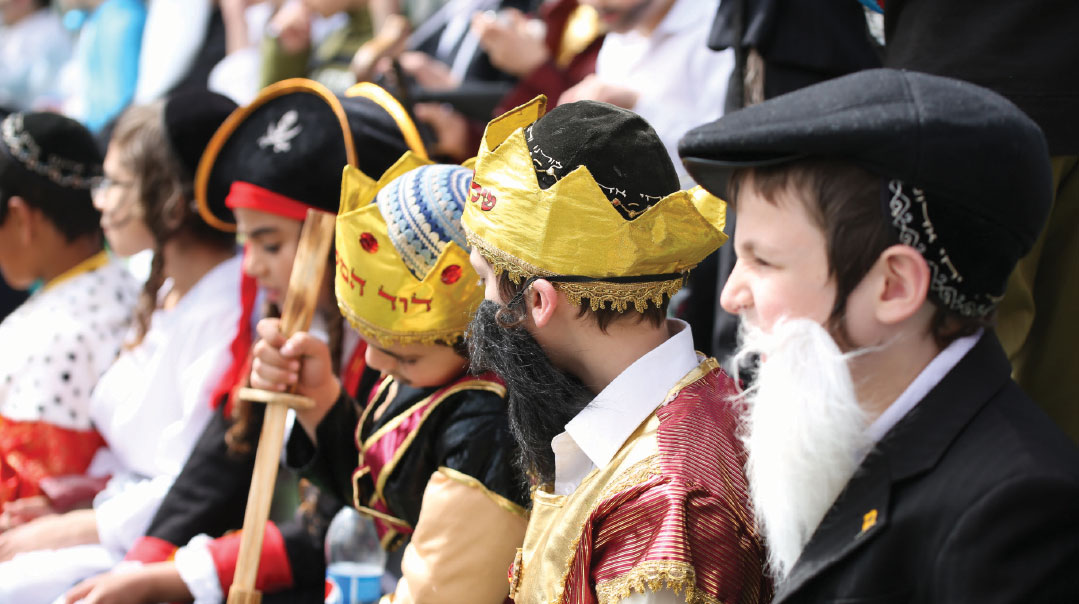All or Nothing

I’ve got all I’ll ever need because He’s the One who’s given it to me, is the only path to simchah

Mishteh v’simchah, feasting and joy. That phrase appears repeatedly in Megillas Esther, and the verse that defines the Purim holiday (Esther 9:22) designates the 14th and 15th of Adar as “days of feasting and joy.” What lies behind this coupling of feasting and joy?
In the tefillah recited following the Megillah reading we say, “Haman aroused the brotherly hatred toward the children,” a seeming allusion to the fact that his loathing for the Jews was but a continuation of the age-old enmity of Eisav toward Yaakov. Similarly, the Targum Yonoson (Shemos 17:8) states that the very first attack Amalek mounted against Klal Yisrael at Refidim was not an impulsive explosion of violence, but instead had its roots in the ideological battle between Yaakov Avinu and his brother Eisav.
From their mother’s womb, these two brothers went their separate ways in life. Their divergent worldviews appear in two adjacent verses in parshas Vayishlach: Yaakov’s guiding principle became Yesh li kol, I have all (Bereishis 33:11), while Eisav expressed his credo with the words Yesh li rav, I have much (Bereishis 33:9). The chasm separating these two perspectives reflects, in turn, a more basic divergence: Since Yaakov understood life to be directed by Hashem, whatever he possessed was precisely what he needed to have to live a happy, fulfilled life; any more or less would only have been to his detriment.
For Eisav, however, life was a random trip through a meaningless universe, and consequently, he developed an all-consuming hunger to possess all the world’s riches and experience all its pleasures. Yet no mortal can have and do it all, not even a fraction of it, and thus his limitless appetite itself became the source of deep frustration and pain. Living life like Eisav guarantees an erratic, roller-coaster ride of a life, full of ecstatic highs and despondent lows, and an ever-present trepidation that just around the corner lurk death, doom, and deprivation.
Hashem intended life in This World to be nothing short of a Gan Eden, as it was for the briefest moment at the beginning of time. What cast Adam out of the Garden then, and still today denies his descendants reentry into it, was and is the belief that we can and must have it all. Among the untold many succulent trees in the Garden of yore, there was but one of which Adam was forbidden to partake, yet he had to have it. Prodded by the nachash, he insisted on eating from that one, too, and as a result, quickly found himself banished beyond the Garden’s gates.
Once elevated by Achashveirosh, Haman seemingly had it all — power, wealth, an influential family, a genocidal plot against the Jews in the works — yet the obstinate refusal of one lone Jew, Mordechai, to kowtow in the slightest leads Haman to bewail his wretched fate with the words v’chol zeh einenu shoveh li, none of this is worth anything to me. That’s how life is for an Eisavnik — peaks and valleys, all or nothing. Is it any wonder, then, that Chazal find an allusion to Haman specifically in Hashem’s rhetorical question/rebuke to Adam, Hamin ha’eitz asher tzivisicha l’vilti achol mimenu achalta? Have you eaten of the tree from which I commanded you to desist? (“Hamin” and “Haman” are the same word.)
The curse Adam brought upon himself that first day finds its echo in the curses foretold for Klal Yisrael in the Tochachah, all of which, the Torah says, can be traced to one central failing: Tachas asher lo avadta es Hashem b’simchah uv’tuv leivav, meirov kol, for not having served Hashem in joy and goodness of heart, out of an abundance of blessing (Devarim 28:47). But those final two words —meirov kol — are understood by some to mean, “due to [having] a majority of all.” When a Jew stops living like Yaakov Avinu, who truly believed and felt he had “kol,” all he could possibly need, and instead starts thinking like Eisav, who was forever ruing that he had only some, or even most of “it all,” but never “all” — that’s when all the terrifying imprecations of the Tochachah ensue.
How to achieve the Yaakovian mindset of yesh li kol? It’s synonymous, says the Torah, with “serving Hashem with simchah, joy, and tuv leivav, goodness of heart.” That latter phrase, in turn, connotes mishteh, for, as Shlomo HaMelech states, V’tov leiv mishteh tamid, the good of heart is in a perpetual state of feasting (Mishlei 15:15).
It’s fascinating to note the one point in the Purim story when, for the most fleeting moment, Haman truly experienced “having it all.” It’s when he leaves the palace as the exclusive invitee to Esther’s feast, signaling that he had really arrived, and how does Megillas Esther describe his state of mind at that moment? “Vayeitzei Haman bayom hahu sameiach v’tov leiv — and Haman went out on the that day joyous and good of heart.” The operative phrase in that verse is bayom hahu, on that day only, for the moment he sees Mordechai refusing to so much as flinch in his presence, all the world crashes down upon him once again. Such is the life of a true descendant of Eisav and heir to his outlook on life.
A deep source of Purim’s unbounded joy lies undiscovered in, of all places, the Tochachah, where the Torah teaches that a perspective of yeish li kol, I’ve got all I’ll ever need because He’s the One who’s given it to me, is the only path to simchah v’tuv leivav, or, in the Megillah’s phrasing, simchah and mishteh.
A freilechen Purim to all!
Originally featured in Mishpacha, Issue 801. Eytan Kobre may be contacted directly at kobre@mishpacha.com
Oops! We could not locate your form.






